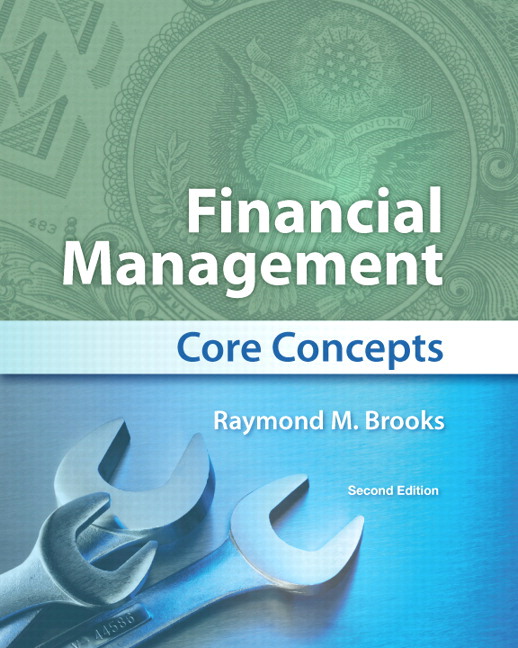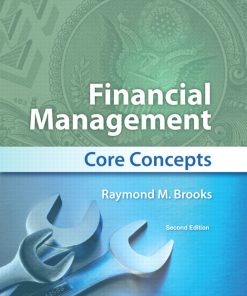Test Bank for Financial Management Core Concepts 2nd Edition by Brooks
$35.00 Original price was: $35.00.$26.50Current price is: $26.50.
Test Bank for Financial Management Core Concepts 2nd Edition by Brooks
SKU: iwnxv729653
Category: Test Bank
Test Bank for Financial Management Core Concepts 2nd Edition by Brooks

Product details:
- ISBN-10 : 0132671948
- ISBN-13 : 978-0132671941
- Author: Brooks
Brooks uses a tools-based approach that presents the key concepts of finance (or “tools”) early on in the text, followed by an application of those concepts to various finance problems. By introducing key finance concepts with personal and business-related finance examples, this text helps readers understand how the tools of finance can help them in any career or business situation.
This edition features strengthened material on financial statements, a discussion on yield curves, new and advanced spreadsheet problems, and updated material.
This edition features strengthened material on financial statements, a discussion on yield curves, new and advanced spreadsheet problems, and updated material.
Table contents:
- Reviewers
- Part One Fundamental Concepts and Basic Tools of Finance
- Chapter 1 Financial Management
- Learning Objectives
- 1.1 The Cycle of Money
- 1.2 Overview of Finance Areas
- 1.3 Financial Markets
- 1.4 The Finance Manager and Financial Management
- 1.5 Objective of the Finance Manager
- Profit Maximization
- Maximizing current stock price
- Maximizing equity value
- 1.6 Internal and External Players
- 1.7 The Legal Forms of Business
- Sole Proprietorship
- Partnership
- Corporations
- Hybrid Corporations
- Not-for-Profit Corporations
- 1.8 The Financial Management Setting: The Agency Model
- 1.9 Corporate Governance and Business Ethics
- 1.10 Why Study Finance?
- Employability
- Key Terms
- Questions
- Prepping for Exams
- Chapter 1 Financial Management At A Glance
- Chapter 2 Financial Statements
- Learning Objectives
- 2.1 Financial Statements
- The Balance Sheet
- Cash account
- Working capital accounts
- Long-term capital assets accounts
- Long-term debt (liabilities) accounts
- Ownership accounts
- The Income Statement
- Issue 1: Generally accepted accounting principles
- Issue 2: Noncash expense items
- Issue 3: Classifying interest expense as part of the financing decision
- Statement of Retained Earnings
- 2.2 Cash Flow Identity and the Statement of Cash Flows
- The First Component: Cash Flow from Assets
- The Second Component: Cash Flow to Creditors
- The Third Component: Cash Flow to Owners
- Putting It All Together: The Cash Flow Identity
- The Statement of Cash Flows
- Free Cash Flow
- 2.3 Financial Performance Reporting
- Regulation Fair Disclosure
- Notes to the Financial Statements
- 2.4 Financial Statements on the Internet
- Key Terms
- Questions
- Prepping for Exams
- Problems
- Advanced Problems for Spreadsheet Application
- Chapter 2 Financial Statements At A Glance
- Chapter 3 The Time Value of Money (Part 1)
- Learning Objectives
- 3.1 Future Value and Compounding Interest
- The Single-Period Scenario
- The Multiple-Period Scenario
- Methods of Solving Future Value Problems
- Method 1: The equation
- Method 2: The TVM keys
- Method 3: The spreadsheet
- 3.2 Present Value and Discounting
- The Single-Period Scenario
- The Multiple-Period Scenario
- The Use of Time Lines
- 3.3 One Equation and Four Variables
- 3.4 Applications of the Time Value of Money Equation
- 3.5 Doubling of Money: The Rule of 72
- Key Terms
- Questions
- Prepping for Exams
- Problems
- Advanced Problems for Spreadsheet Application
- Chapter 3 The Time Value of Money (Part 1) At A Glance
- Chapter 4 The Time Value of Money (Part 2)
- Learning Objectives
- 4.1 Future Value of Multiple Payment Streams
- 4.2 Future Value of an Annuity Stream
- Future Value of an Annuity: An Application
- 4.3 Present Value of an Annuity
- 4.4 Annuity Due and Perpetuity
- Perpetuity
- 4.5 Three Loan Payment Methods
- Interest and Principal at Maturity of Loan (Discount Loan)
- Interest as You Go, Principal at Maturity of Loan (Interest-Only Loan)
- Interest and Principal as You Go (Amortized Loan)
- 4.6 Amortization Schedules
- 4.7 Waiting Time and Interest Rates for Annuities
- 4.8 Solving a Lottery Problem
- 4.9 Ten Important Points about the TVM Equation
- Key Terms
- Questions
- Prepping for Exams
- Problems
- Advanced Problems for Spreadsheet Application
- Chapter 4 The Time Value of Money (Part 2) At A Glance
- Chapter 5 Interest Rates
- Learning Objectives
- 5.1 How Financial Institutions Quote Interest Rates: Annual and Periodic Interest Rates
- 5.2 Effect of Compounding Periods on the Time Value of Money Equations
- 5.3 Consumer Loans and Amortization Schedules
- 5.4 Nominal and Real Interest Rates
- 5.5 Risk-Free Rate and Premiums
- Maturity Premiums
- 5.6 Yield Curves
- 5.7 A Brief History of Interest Rates and Inflation in the United States
- Key Terms
- Questions
- Prepping for Exams
- Problems
- Advanced Problems for Spreadsheet Application
- Chapter 5 Interest Rates At A Glance
- Part Two Valuing Stocks and Bonds and Understanding Risk and Return
- Chapter 6 Bonds and Bond Valuation
- Learning Objectives
- 6.1 Application of the Time Value of Money Tool: Bond Pricing
- Key Components of a Bond
- Pricing a Bond in Steps
- Method 1: Using the equation
- Method 2: Using the TVM keys
- Method 3: Using a spreadsheet
- 6.2 Semiannual Bonds and Zero-Coupon Bonds
- Pricing Bonds after Original Issue
- Method 1: Using the equation
- Method 2: Using the TVM keys
- Method 3: Using a spreadsheet
- Zero-Coupon Bonds
- Amortization of a Zero-Coupon Bond
- 6.3 Yields and Coupon Rates
- The First Interest Rate: Yield to Maturity
- Method 1: Using the equation
- Method 2: Using the TVM keys
- Method 3: Using a spreadsheet
- The “Other” Interest Rate: Coupon Rate
- Relationship of Yield to Maturity and Coupon Rate
- 6.4 Bond Ratings
- 6.5 Some Bond History and More Bond Features
- 6.6 U.S. Government Bonds
- Pricing a U.S. Government Note or Bond
- Method 2: Using the TVM keys
- Method 3: Using a spreadsheet
- Pricing a Treasury Bill
- Key Terms
- Questions
- Prepping for Exams
- Problems
- Advanced Problems for Spreadsheet Application
- Chapter 6 Bonds and Bond Valuation At A Glance
- Chapter 7 Stocks and Stock Valuation
- Learning Objectives
- 7.1 Characteristics of Common Stock
- Ownership
- Claim on Assets and Cash Flow (Residual Claim)
- Vote (Voice in Management)
- No Maturity Date
- Dividends and Their Tax Effect
- Authorized, Issued, and Outstanding Shares
- Treasury Stock
- Preemptive Rights
- 7.2 Stock Markets
- Primary Markets
- Secondary Markets: How Stocks Trade
- Bull Markets and Bear Markets
- 7.3 Stock Valuation
- The Constant Dividend Model with an Infinite Horizon
- The Constant Dividend Model with a Finite Horizon
- Method 1: Using the equation
- Method 2: Using the TVM keys
- The Constant Growth Dividend Model with an Infinite Horizon
- The Constant Growth Dividend Model with a Finite Horizon
- Nonconstant Growth Dividends
- 7.4 Dividend Model Shortcomings
- 7.5 Preferred Stock
- 7.6 Efficient Markets
- Operational Efficiency
- Informational Efficiency
- Key Terms
- Questions
- Prepping for Exams
- Problems
- Advanced Problems for Spreadsheet Application
- Chapter 7 Stocks and Stock Valuation At A Glance
- Chapter 8 Risk and Return
- Learning Objectives
- 8.1 Returns
- Dollar Profits and Percentage Returns
- Converting Holding Period Returns to Annual Returns
- Method 1: Using equations
- Method 2: Using the TVM keys
- Extrapolating Holding Period Returns
- 8.2 Risk (Certainty and Uncertainty)
- 8.3 Historical Returns
- 8.4 Standard Deviation as a Measure of Risk
- Normal Distributions
- 8.5 Returns in an Uncertain World (Expectations and Probabilities)
- Determining the Probabilities of All Potential Outcomes
- 8.6 The Risk-and-Return Trade-Off
- Investment Rules
- 8.7 Diversification: Minimizing Risk or Uncertainty
- When Diversification Works
- Adding More Stocks to the Portfolio: Systematic and Unsystematic Risk
- 8.8 Beta: The Measure of Risk in a Well-Diversified Portfolio
- 8.9 The Capital Asset Pricing Model and the Security Market Line
- The Capital Asset Pricing Model
- Application of the SML
- Key Terms
- Questions
- Prepping for Exams
- Problems
- Advanced Problems for Spreadsheet Application
- Chapter 8 Risk and Return At A Glance
- Part Three Capital Budgeting
- Chapter 9 Capital Budgeting Decision Models
- Learning Objectives
- 9.1 Short-Term and Long-Term Decisions
- 9.2 Payback Period and Discounted Payback Period
- Payback Period
- Discounted Payback Period
- 9.3 Net Present Value
- Mutually Exclusive versus Independent Projects
- Unequal Lives of Projects
- Net Present Value Example: Equation and Calculator Function
- 9.4 Internal Rate of Return and Modified Internal Rate of Return
- Internal Rate of Return
- Appropriate discount rate or hurdle rate
- Problems with the internal rate of return
- Multiple Internal Rates of Return
- Reinvestment and Crossover Rates
- Modified Internal Rate of Return
- 9.5 Profitability Index
- 9.6 Overview of Six Decision Models
- Capital Budgeting Using a Spreadsheet
- Key Terms
- Questions
- Prepping for Exams
- Problems
- Advanced Problems for Spreadsheet Application
- Chapter 9 Capital Budgeting Decision Models At A Glance
- Chapter 10 Cash Flow Estimation
- Learning Objectives
- 10.1 The Importance of Cash Flow
- 10.2 Estimating Cash Flow for Projects: Incremental Cash Flow
- Sunk Costs
- Opportunity Costs
- Erosion Costs
- Synergy Gains
- Working Capital
- 10.3 Capital Spending and Depreciation
- Straight-Line Depreciation
- Modified Accelerated Cost Recovery System
- 10.4 Cash Flow and the Disposal of Capital Equipment
- 10.5 Projected Cash Flow for a New Product
- Key Terms
- Questions
- Prepping for Exams
- Problems
- Advanced Problems for Spreadsheet Application
- Chapter 10 Cash Flow Estimation At A Glance
- Chapter 11 The Cost of Capital
- Learning Objectives
- 11.1 The Cost of Capital: A Starting Point
- 11.2 Components of the Weighted Average Cost of Capital
- Debt Component
- Preferred Stock Component
- Equity Component
- The security market line approach to Re
- The dividend growth model approach to Re
- Retained Earnings
- The Debt Component and Taxes
- 11.3 Weighting the Components: Book Value or Market Value?
- Book Value
- Adjusted Weighted Average Cost of Capital
- Market Value
- 11.4 Using the Weighted Average Cost of Capital in a Budgeting Decision
- The Weighted Average Cost of Capital for Individual Projects
- 11.5 Selecting Appropriate Betas for Projects
- 11.6 Constraints on Borrowing and Selecting Projects for the Portfolio
- Key Terms
- Questions
- Prepping for Exams
- Problems
- Advanced Problems for Spreadsheet Application
- Chapter 11 The Cost of Capital At A Glance
- Part Four Financial Planning and Evaluating Performance
- Chapter 12 Forecasting and Short-Term Financial Planning
- Learning Objectives
- 12.1 Sources and Uses of Cash
- 12.2 Cash Budgeting and the Sales Forecast
- Cash Inflow from Sales
- Other Cash Receipts
- 12.3 Cash Outflow from Production
- 12.4 The Cash Forecast: Short-Term Deficits and Short-Term Surpluses
- Funding Cash Deficits
- Investing Cash Surpluses
- 12.5 Planning with Pro Forma Financial Statements
- Pro Forma Income Statement
- Pro Forma Balance Sheet
- Key Terms
- Questions
- Prepping for Exams
- Problems
- Advanced Problems for Spreadsheet Application
- Chapter 12 Forecasting and Short-Term Financial Planning At A Glance
- Chapter 13 Working Capital Management
- Learning Objectives
- 13.1 The Cash Conversion Cycle
- Average Production Cycle
- Average Collection Cycle
- Average Payment Cycle
- Putting It All Together: The Cash Conversion Cycle
- 13.2 Managing Accounts Receivable and Setting Credit Policy
- Collecting Accounts Receivable
- Credit: A Two-Sided Coin
- Qualifying for Credit
- Setting Payment Policy
- Collecting Overdue Debt
- 13.3 The Float
- Speeding Up the Collection Float (Shortening the Lag Time)
- Extending the Disbursement Float (Lengthening the Lag Time)
- 13.4 Inventory Management: Carrying Costs and Ordering Costs
- ABC Inventory Management
- Redundant Inventory Items
- Economic Order Quantity
- The trade-off between ordering costs and carrying costs
- Measuring ordering costs
- Measuring carrying costs
- Reorder point and safety stock
- Just in Time
- 13.5 The Effect of Working Capital on Capital Budgeting
- Inventories and Daily Operations
- Key Terms
- Questions
- Prepping for Exams
- Problems
- Advanced Problems for Spreadsheet Application
- Chapter 13 Working Capital Management At A Glance
- Chapter 14 Financial Ratios and Firm Performance
- Learning Objectives
- 14.1 Financial Statements
- Benchmarking
- 14.2 Financial Ratios
- Short-Term Solvency: Liquidity Ratios
- Long-Term Solvency: Financial Leverage Ratios
- Asset Management Ratios
- Profitability Ratios
- Market Value Ratios
- DuPont Analysis
- 14.3 External Uses of Financial Statements and Industry Averages
- Cola Wars
- Industry Ratios
- Key Terms
- Questions
- Prepping for Exams
- Problems
- Advanced Problems for Spreadsheet Application
- Chapter 14 Financial Ratios and Firm Performance At A Glance
- Part Five Other Selected Finance Topics
- Chapter 15 Raising Capital
- Learning Objectives
- 15.1 The Business Life Cycle
- 15.2 Borrowing for a Start-Up and a Growing Business
- Personal Funds and Family Loans
- Commercial Bank Loans
- Commercial Bank Loans through the Small Business Administration
- Angel Financing and Venture Capital
- Financial strength
- Contacts
- Exit strategy
- 15.3 Borrowing for a Stable and Mature Business: Taking Out Bank Loans
- Straight Loans
- Discount Loans
- Letters of Credit or Lines of Credit
- Compensating Balance Loans
- 15.4 Borrowing for a Stable and Mature Business: Selling Bonds
- 15.5 Borrowing for a Stable and Mature Business: Selling Stock
- Initial Public Offerings and Underwriting
- Registration, Prospectus, and Tombstone
- The Marketing Process: Road Show
- The Auction
- The Aftermarket: Dealer in the Shares
- 15.6 Other Borrowing Options for a Mature Business
- 15.7 The Final Phase: Closing the Business
- Straight Liquidation: Chapter 7
- Reorganization: Chapter 11
- Key Terms
- Questions
- Prepping for Exams
- Problems
- Advanced Problems for Spreadsheet Application
- Chapter 15 Raising Capital At A Glance
- Chapter 16 Capital Structure
- Learning Objectives
- 16.1 Capital Markets: A Quick Review
- 16.2 Benefits of Debt
- Earnings per Share as a Measure of the Benefits of Borrowing
- 16.3 Break-Even Earnings for Different Capital Structures
- 16.4 Pecking Order
- Firms Prefer Internal Financing First
- Firms Choose to Issue the Cheapest Security First and Use Equity as a Last Resort
- 16.5 Modigliani and Miller on Optimal Capital Structure
- Capital Structure in a World of No Taxes and No Bankruptcy
- M&M Proposition I
- M&M Proposition II
- Capital Structure in a World of Corporate Taxes and No Bankruptcy
- Debt and the Tax Shield
- 16.6 The Static Theory of Capital Structure
- Bankruptcy
- Optimal Capital Structure
- Key Terms
- Questions
- Prepping for Exams
- Problems
- Advanced Problems for Spreadsheet Application
- Chapter 16 Capital Structure At A Glance
- Chapter 17 Dividends, Dividend Policy, and Stock Splits
- Learning Objectives
- 17.1 Cash Dividends
- Buying and Selling Stock
- Declaring and Paying a Cash Dividend: A Chronology
- Different Types of Dividends
- Regular cash dividends
- Special or extra cash dividends
- Stock dividends
- Liquidating dividends
- 17.2 Dividend Policy
- Dividend Clienteles
- Dividend Policy Irrelevance
- Dividend policy in a world of no taxes and no transaction costs
- Dividends in a world of taxes
- Reasons Favoring a Low- or No-Dividend-Payout Policy
- Tax advantages
- Higher potential returns from positive net present value projects
- Less need for outside funding
- Reasons Favoring a High-Dividend-Payout Policy
- Freedom from transaction costs
- Certainty versus uncertainty
- Optimal Dividend Policy
- 17.3 Selecting a Dividend Policy
- Some Further Considerations in the Selection of a Dividend Policy
- Restrictions on legal capital
- Restrictive bond covenants
- Cash availability
- 17.4 Stock Dividends, Stock Splits, and Reverse Splits
- Reasons for Stock Splits
- Preferred trading range
- Signaling hypothesis
- Increased liquidity
- Reverse Splits
- 17.5 Specialized Dividend Plans
- Stock Repurchase
- Dividend Reinvestment Plans
- Key Terms
- Questions
- Prepping for Exams
- Problems
- Advanced Problems for Spreadsheet Application
- Chapter 17 Dividends, Dividend Policy, and Stock Splits At A Glance
- Chapter 18 International Financial Management
- Learning Objectives
- 18.1 Managing Multinational Operations
- Cultural Risk
- Differences in ownership structure
- Differences in human resource norms
- Religious heritage of the host country
- Nepotism and corrupt practices in the host country
- Intellectual property rights
- Business Risk
- Political Risk
- 18.2 Foreign Exchange
- Purchasing Power Parity
- Currency Exchange Rates
- Cross Rates
- Arbitrage Opportunities
- Forward Rates
- Using Forward Rates
- Changing Spot Rates
- 18.3 Transaction, Operating, and Translation Exposures
- Transaction Exposure
- Operating Exposure
- Translation Exposure
- 18.4 Foreign Investment Decisions
- Key Terms
- Questions
- Prepping for Exams
- Problems
- Advanced Problems for Spreadsheet Application
- Questions
- Chapter 18 International Financial Management At A Glance
- Appendix 1 Future Value Interest Factors
- Appendix 2 Present Value Interest Factors
- Appendix 3 Future Value Interest Factors of an Annuity
- Appendix 4 Present Value Interest Factors of an Annuity
- Appendix 5 Answers to Prepping for Exam Question
People also search:
financial management core concepts pdf
financial management core concepts
financial management core concepts 4th edition pdf
core financial concepts
key financial concepts
You may also like…
Sale!
Sale!
Sale!
Sale!
Sale!
Sale!
Sale!
Sale!
Sale!
Test Bank
Test Bank for Core Concepts of Government and Not-for-Profit Accounting, 2nd Edition, Granof,












